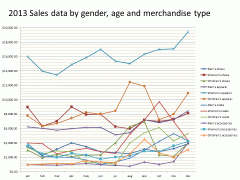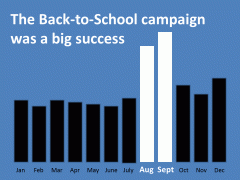That’s how I feel about charts, graphs and spreadsheets.
So many speakers fill their presentation PowerPoint slides with charts, graphs and spreadsheets, they surround themselves with them, and they’re the wrong charts, graphs and spreadsheets.
Charts, graphs and spreadsheets are a wonderful way to visualize data. Organizing the raw data in a structured matrix, like an Excel spreadsheet, or charting or graphing it, allows us to see things that we might not have otherwise noticed.
Anomalies jump out at us. Subtle trends are made apparent. We can play with parameters of a graph to focus on the macro or the micro. We can process the spreadsheet data to tease out previously unseen correlations. We can mine the data to our hearts content.
But when we are giving a presentation, that’s not what we are doing, at least I hope not, and it’s certainly not what we want our audience to be doing.
When we speak, we want the audience to be paying attention to our argument, proposal, procedure or scenario, not analyzing the data. The purpose of a PowerPoint slide is to reinforce our words visually. Each needs to make the same single, clear and unambiguous point we are making, at that moment, with our words.
That’s the purpose of presentation charts, graphs and spreadsheets, not to visualize the data, but to visually reinforce, support and validate our words.
If you feel the need to supply your audience with the full range of data, by all means, provide them with all the analytical charts, graphs and spreadsheets they can carry…….., after your presentation. Let them wallow in the data to their heart’s content, just as you did.
But build your presentation slides to make one clear point.











{ 4 comments… read them below or add one }
Russ:
Excellent post, as usual. Your two examples of presentation charts fit Michael Alley’s Assertion-Evidence slide design, which I described in detail in a blog post back in February:
http://joyfulpublicspeaking.blogspot.com/2014/02/assertion-evidence-powerpoint-slides.html
Less seriously, what do you think of Thomas Dillon’s July 16th Japan Times column titled Ten tips for shaking stage fright, aka ‘the American disease’? I blogged about it too:
http://joyfulpublicspeaking.blogspot.com/2014/08/is-stage-fright-just-american-disease.html
Richard
You list some excellent resources in your post, Richard. I’ll have to dig into those. It feels odd to think that you’ve had an original take on a subject, only to later realize that others not only thought along the same lines, but were far ahead of you.
I teach at three Japanese universities, and my students are just as, if not far more, terrified by public speaking than American students, even in the context of a small classroom group of their friends. Many of them have never before given an oral presentation.
In school or in business situations, they tend to cover their nervousness by focusing intently on their script or PowerPoint. That’s one of the reasons Japanese business presentations are so deadly dull.
I feel the same, when people without business backgrounds or any business education are “teaching” business communication, business presentations, or anything related to business. Having some degree in speech, communication, or English doesn’t make that person an expert in ANY business field.
An equal feeling (if not more so) are North American teachers who preach how wonderful American speech giving techniques are far more superior. I both disagree and find it rude. Instead of learning the qualities of host nation cultural diversity and building upon it…. such teachers fall prey to their own crap which they pander with fervor; like crazed cult followers of previous nonsense regurgitated by other fellow Americans.
While I agree that cultural standards differ, I do think that there are certain universal principals of clear and persuasive communication.
I believe many of the methods and structures I teach would be equally effective in a Japanese presentation, but I stress to my students that it is up to them to apply only what they feel is appropriate to their internal Japanese corporate communications.
If, on the other hand, they are presenting to an international or western audience, the dry, dull, script and PowerPoint-driven style of a Japanese presentation will fail miserably. They know, or have experienced, that, which is why they come to me in the first place.